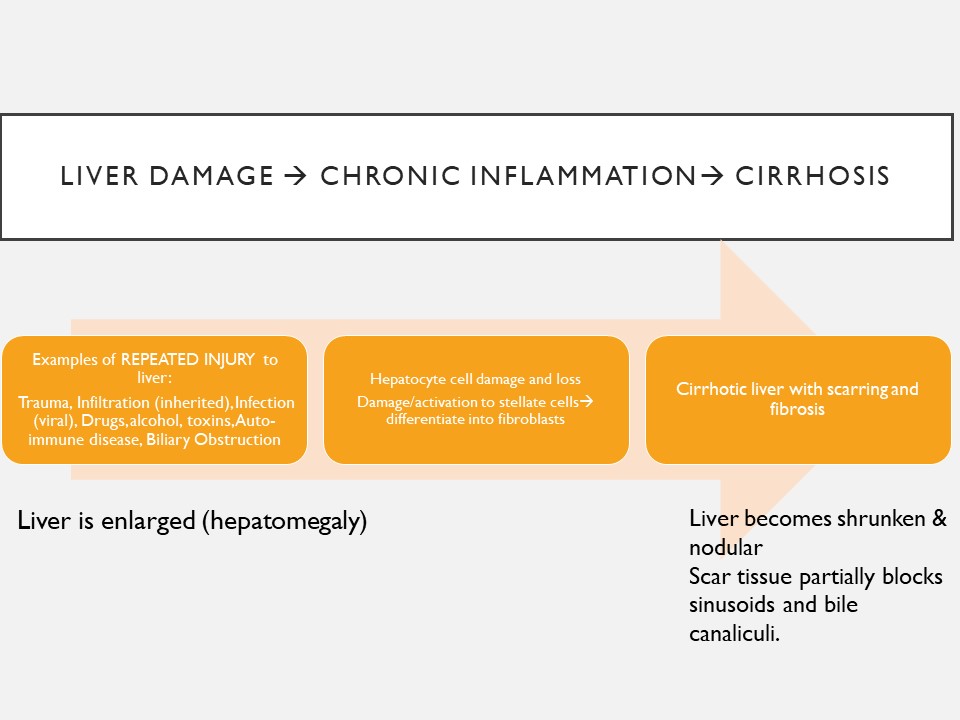Cirrhosis
Causes and Pathophysiology of Cirrhosis
Jennifer Kong
Learning Objectives
By the end of this chapter, you will be able to:
- Explain how repeated damage leads to physical changes in liver structure and function.
- Name possible causes of repeated liver damage that can lead to cirrhosis.

Infection of the Liver
Volume-Induced Trauma
- cardiac cirrhosis: right sided heart failure will cause a back up of blood into the both the superior vena cava (SVC) and IVC. Because the hepatic vein drains directly into the IVC, any excessive blood in IVC will naturally flow into the liver.
- physical obstructions within the biliary tree: bile is continuously made and drained from the liver via the biliary tree. Anything that prevents bile draining into the duodenum will essentially cause a back up of bile up into the liver. Gallstones, bile duct narrowing or congenital defects (e.g. biliary atresia) can all lead to obstructions of the biliary tree
- inheritable disease that cause ducts to plug (e.g. Cystic Fibrosis): and anything else that causes blockage of a duct or slowing down of liver drainage (e.g. fluid secretions like bile becoming thick due to cystic fibrosis) will leading to excessive volume that will harm the hepatocytes.
Direct Damage to Hepatocytes
- Inflammatory response: a healthy immune system resides in the liver (i.e. Kupffer cells/hepatic macrophages) which requires alpha-1-antitrypsin to prevent damage to normal tissue (see Emphysema chapter). Inheritable alpha-1-antitrypsin deficiency will cause unregulated inflammatory response which results in damaging normal tissue along with the intended infected/damaged liver tissue.
- Autoimmune: a healthy immune system resides in the liver (ie Kupffer cells/hepatic macrophages). And overactive immune system – such as in autoimmune diseases like lupus in which healthy tissue becomes inappropriately targeted for destruction by immune system cells that can injure and destroy functional hepatocytes, thus causing a subsequent inflammatory response which exacerbates the problem.
- Alcohol- and non-alcohol fatty liver disease: Hepatocytes store many nutrients and sometimes that storage will cause damage to the surrounding hepatocytes. Alcohol is metabolized in the liver and stored as fat. Similarly, some fat is normally stored in hepatocytes from what is absorbed in the diet. However, excessive fat storage damages the hepatocyte through formation of reactive oxygen species. In addition an excessive amount of the cytoplasm being occupied by fat droplets will impede hepatocyte function.
- Infiltrative disease: inheritable conditions sometimes cause abnormal uptake and storage of minerals (e.g. Hemochromatosis, Wilsons disease, sarcoidosis). Although the liver does store some minerals, abnormally high amounts of stored minerals, like iron become damaging to hepatocytes.
- medications/toxins: Hepatocytes detoxify substances at a phenomenal rate. However, it is possible that it can exhaust itself if required. Certain medications, chemotherapy agents, or a combination of medications may literally ‘burn out’ the hepatocyte as it works hard to detoxify. As well, toxins can start to accumulate in the liver causing further damage.
Section Review
Chronic, repeated damage to the liver will both damage hepatocytes and stimulate inflammation that leads to tissue changes. As a result, the liver loses function and gathers fibrotic scar tissue that does not have hepatocyte function nor the same low flow resistance properties as the original liver tissue. Causes of repeated injury to liver can be classified based on repeated infection (i.e. hepatitis), volume overload of the liver (i.e. congestion of blood as in heart failure, back up of bile as in biliary obstruction), and direct damage to hepatocytes (i.e. chemical toxins, accumulation/infiltration of damaging substances, inflammatory attack of hepatocytes)
Review Questions
1. Select the correct word for the sentence. Cirrhosis is caused by acute OR repeated damage to the liver. An example of an infectious cause of cirrhosis is pneumonia OR heart failure OR chronic Hepatitis B OR acute Hepatitis A. Repeated obstructions of the biliary tree will cause a backup of bile OR blood OR digestive juice into the liver causing a fluid overload that damages the liver. Hepatocytes that accumulate iron OR copper OR fat OR starch can cause repeated damage leading to a condition known as non-alcoholic fatty liver disease that can progress to cirrhosis.
2. Explain how autoimmune disease can possibly lead to cirrhosis.
Answer Key
- repeated, chronic Hepatitis B, bile, fat
- The body’s immune system incorrectly recognizes something in the liver as a possible pathogen. As such, the immune system repeatedly attacks the liver, causing death of hepatocytes and deposition of scar tissue leading to cirrhosis.
Media Attributions
- Cirrhosis pathology © Jennifer Kong is licensed under a CC BY-NC (Attribution NonCommercial) license

